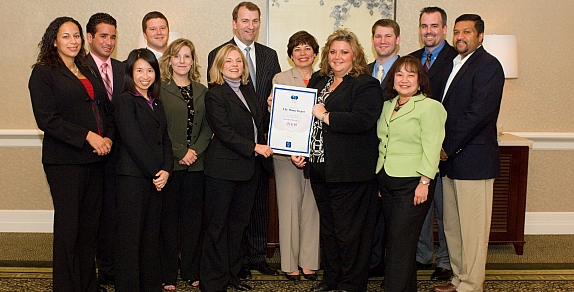
Home Depot Best in Class
Lorem ipsum dolor sit amet, consectetur adipiscing elit. Ut elit tellus, luctus nec ullamcorper mattis, pulvinar dapibus leo.

SIGNIFICANT COST ADVANTAGES FROM CHINA SOURCING PROGRAMS
China’s entry in to the World Trade Organization in November 2001 can rightly be adjudged as the beginning of the present era of globalization. The figures for internationally traded goods between 2004 and 2014 show just how enormous an impact on world trade it had with a doubling of the value of such trade from $10 Trillion to $20 Trillion over the period. This translates directly to a significant increase in container flow, China witnessed a 500% increase in container throughput from 2002-2012.
More than 40% of America’s imports were from the overseas subsidiaries of its corporations with China accounting for about 25% of the global growth of GDP. Globally, comparative advantages were shifting rapidly, leading to the de-industrialization in North America and Europe, and a re-industrialization of Asia. Industry forecasts on low cost sourcing trends, pointed to an 18% increase in spend by Fortune 500 brands on sourcing in low —cost platforms over the 3 years between 2006 and 2009, with expenditure expected to rise from 21% to 39% over the same period.
These factors were imposing a major shift in global freight flows and creating an ever- lengthening supply chain. Economic development in China had been the prevailing factor behind the growth of international transportation. The trading distances involved were often considerable and this had resulted in increased demands on both the maritime shipping industry and on port activities.
As its industrial and manufacturing activities developed, China was importing growing quantities of raw materials and energy and exporting increasing quantities of manufactured goods. Consequently there had been a surge in demand for the movement of goods. The ports in the Pearl River Delta in Guangdong Province, now handled almost as many containers as the ports in the United States combined.
All indications were that this development was set to continue.
Shippers are realizing significant cost advantages through their China sourcing programs, with consumer goods and retail companies gaining annual savings that ranged from 9 to 46% on selected items sourced from China. However, such savings had been accompanied by negative effects to supply chains, such as longer lead times, unreliable delivery, and slower turn on inventory.
Academics commenting on the logistics implications associated with China’s accession to the WTO, identified that the science of logistics in China was in its infancy and that tight regulation, large levels of bureaucracy together with cultural and skills challenges were hampering its effectiveness. However they were confident that global 3PL’s would plug the gap on behalf of companies sourcing or manufacturing there.
As globalisation increasingly drives shippers to seek to track their goods at every stage, the container port is becoming a facilitator and partner in the supply chain. It is becoming easier than ever to forge international business ties, thanks to the internet, global communication and improved transport infrastructure. But either sourcing raw materials or finding a global customer for your finished goods are only first steps in a journey toward fulfilling those obligations.
With the push towards efficient manufacturing processes such as “lean” and “six sigma” continuing, it’s not enough to know that critical parts or stocks are on the way or have been shipped. You need to know where they are in the supply chain, whether they’ve cleared customs, whether they’re sitting in a warehouse or if they’re on the last leg in a journey to your loading dock or your customer.
But keeping up with inbound and outbound shipments globally is not a core competency for manufacturers. So thirdparty logistics (3PL) providers have emerged. In 2005, 3PL providers based in the US had total annual revenues of about $100bn. Fourth-party logistics (4PL) providers have also emerged recently. These manage supply chains from various suppliers while acting as the intermediary between the manufacturer and its suppliers.
Both types of provider can help manufacturers to negotiate the maze involved in shipping goods around the corner or around the world. On behalf of the shipper, they stay in touch with shipments at each stage in its journey. To facilitate this continuous visibility, more and more 3PLs are working to improve their relationships with port operators. As the custodians of the export and import gateways used by the shipment, these operators have an enormous influence on the safe, secure, efficient and timely execution of the dispatch and receipt of the container(s) in question.
Home Depot who were importing more than 100,000 TEU per annum from the region were the “Thought Leaders” in their peer group in logistics execution. In particular Home Depot and their team led by Rosa Hakala and Ben Cook, were pioneers in fostering direct relationships with container terminal operators, who they viewed as vital in ensuring the integrity of their supply chains. Home Depot together with their ocean carrier and 3PL conducted face to face meetings with the port authority, terminal operator and other port stakeholders.
The evolutions in supply chains and logistics models urge container terminal operators to re-think their function in the logistics process. Terminals are central to the design of supply chains and are considered as strategic assets.
Findings from the Institutes research program “U.S. Beneficial Cargo Owners Sourcing in China: The Logistics Challenges” identified that “Best in Class” international logistics departments supporting procurement departments sourcing intercontinentally, demand direct relationships with each stakeholder in the logistics process.
The majority of Fortune 500 companies outsource directly to third party logistics provider’s (3PL’s) however it is regarded as “best practice” to have direct contact with the the key logistics service providers, particularly the liner shipping company and the container terminal operator.
Home Depot who the Institute has accredited as “Best In Class” in the execution Of Container Logistics Strategy pioneered direct relationships with container terminal operators.
The driver for this is that Beneficial Cargo Owners (BCO’s) do not have contractual relationship with any of stakeholders inside the port, leading to a dependence on third parties for status reports etc. This can lead to misreporting and guessing about the status of a particular container. This is mitigated by container terminal operators liaising directly with BCO’s and their 3PL’s.
BCO’s report that direct relationships with container terminal operators has led directly to greater Visibility, increased Velocity and added Value add in their container logistics processes.
For terminal operators direct relationships with their end user had a direct influence on decisions by shipping lines to include their terminal on their network maps. Shipping lines are heavily influenced by their upstream customers − the port’s end users.
The collaboration also leads to logistics innovation particularly in the area of “Port Centric Logistics”
SIGNIFICANT COST ADVANTAGES FROM CHINA SOURCING PROGRAMS
China’s entry in to the World Trade Organization in November 2001 can rightly be adjudged as the beginning of the present era of globalization. The figures for internationally traded goods between 2004 and 2014 show just how enormous an impact on world trade it had with a doubling of the value of such trade from $10 Trillion to $20 Trillion over the period. This translates directly to a significant increase in container flow, China witnessed a 500% increase in container throughput from 2002-2012.
More than 40% of America’s imports were from the overseas subsidiaries of its corporations with China accounting for about 25% of the global growth of GDP. Globally, comparative advantages were shifting rapidly, leading to the de-industrialization in North America and Europe, and a re-industrialization of Asia. Industry forecasts on low cost sourcing trends, pointed to an 18% increase in spend by Fortune 500 brands on sourcing in low —cost platforms over the 3 years between 2006 and 2009, with expenditure expected to rise from 21% to 39% over the same period.
These factors were imposing a major shift in global freight flows and creating an ever- lengthening supply chain. Economic development in China had been the prevailing factor behind the growth of international transportation. The trading distances involved were often considerable and this had resulted in increased demands on both the maritime shipping industry and on port activities.
As its industrial and manufacturing activities developed, China was importing growing quantities of raw materials and energy and exporting increasing quantities of manufactured goods. Consequently there had been a surge in demand for the movement of goods. The ports in the Pearl River Delta in Guangdong Province, now handled almost as many containers as the ports in the United States combined.
All indications were that this development was set to continue.
Shippers are realizing significant cost advantages through their China sourcing programs, with consumer goods and retail companies gaining annual savings that ranged from 9 to 46% on selected items sourced from China. However, such savings had been accompanied by negative effects to supply chains, such as longer lead times, unreliable delivery, and slower turn on inventory.
Academics commenting on the logistics implications associated with China’s accession to the WTO, identified that the science of logistics in China was in its infancy and that tight regulation, large levels of bureaucracy together with cultural and skills challenges were hampering its effectiveness. However they were confident that global 3PL’s would plug the gap on behalf of companies sourcing or manufacturing there.
As globalisation increasingly drives shippers to seek to track their goods at every stage, the container port is becoming a facilitator and partner in the supply chain. It is becoming easier than ever to forge international business ties, thanks to the internet, global communication and improved transport infrastructure. But either sourcing raw materials or finding a global customer for your finished goods are only first steps in a journey toward fulfilling those obligations.
With the push towards efficient manufacturing processes such as “lean” and “six sigma” continuing, it’s not enough to know that critical parts or stocks are on the way or have been shipped. You need to know where they are in the supply chain, whether they’ve cleared customs, whether they’re sitting in a warehouse or if they’re on the last leg in a journey to your loading dock or your customer.
But keeping up with inbound and outbound shipments globally is not a core competency for manufacturers. So thirdparty logistics (3PL) providers have emerged. In 2005, 3PL providers based in the US had total annual revenues of about $100bn. Fourth-party logistics (4PL) providers have also emerged recently. These manage supply chains from various suppliers while acting as the intermediary between the manufacturer and its suppliers.
Both types of provider can help manufacturers to negotiate the maze involved in shipping goods around the corner or around the world. On behalf of the shipper, they stay in touch with shipments at each stage in its journey. To facilitate this continuous visibility, more and more 3PLs are working to improve their relationships with port operators. As the custodians of the export and import gateways used by the shipment, these operators have an enormous influence on the safe, secure, efficient and timely execution of the dispatch and receipt of the container(s) in question.
Home Depot who were importing more than 100,000 TEU per annum from the region were the “Thought Leaders” in their peer group in logistics execution. In particular Home Depot and their team led by Rosa Hakala and Ben Cook, were pioneers in fostering direct relationships with container terminal operators, who they viewed as vital in ensuring the integrity of their supply chains. Home Depot together with their ocean carrier and 3PL conducted face to face meetings with the port authority, terminal operator and other port stakeholders.
The evolutions in supply chains and logistics models urge container terminal operators to re-think their function in the logistics process. Terminals are central to the design of supply chains and are considered as strategic assets.
Findings from the Institutes research program “U.S. Beneficial Cargo Owners Sourcing in China: The Logistics Challenges” identified that “Best in Class” international logistics departments supporting procurement departments sourcing intercontinentally, demand direct relationships with each stakeholder in the logistics process.
The majority of Fortune 500 companies outsource directly to third party logistics provider’s (3PL’s) however it is regarded as “best practice” to have direct contact with the the key logistics service providers, particularly the liner shipping company and the container terminal operator.
Home Depot who the Institute has accredited as “Best In Class” in the execution Of Container Logistics Strategy pioneered direct relationships with container terminal operators.
The driver for this is that Beneficial Cargo Owners (BCO’s) do not have contractual relationship with any of stakeholders inside the port, leading to a dependence on third parties for status reports etc. This can lead to misreporting and guessing about the status of a particular container. This is mitigated by container terminal operators liaising directly with BCO’s and their 3PL’s.
BCO’s report that direct relationships with container terminal operators has led directly to greater Visibility, increased Velocity and added Value add in their container logistics processes.
For terminal operators direct relationships with their end user had a direct influence on decisions by shipping lines to include their terminal on their network maps. Shipping lines are heavily influenced by their upstream customers − the port’s end users.
The collaboration also leads to logistics innovation particularly in the area of “Port Centric Logistics”
Press Release
ATLANTA JULY 2006
HOME DEPOT DESIGNATED BEST IN CLASS
The Global Institute of Logistics announced the result as part of its research program UNITED STATES BCO’S SOURCING IN CHINA: THE LOGISTICS CHALLENGES”. The results point to a new and more dynamic approach to logistics challenges in the maritime container logistics supply chain in Southern China particularly in and around the Port of Shenzhen
“United States BCO’s Sourcing in China: The Logistics Challenges” is an ongoing Institute research program focussed on southern China . The first module examined on how the US Beneficial Cargo Owners (BCO’s) from the consumer goods and retail sectors were coping with this region’s particular logistical challenges.
The research program is designed to understand how companies manage the dynamics of global trade in this new scenario and to determine how the most adaptive were coping with its challenges. Furthermore The aim of the research is to establish accepted best practice by the stakeholders in Sino–US trade, creating ‘bench-marks’ and to promote standard operating procedures and their adoption by other shippers.
The research identified the early adopters at brand level and led to the accreditation of Home Depot with “Best in Class” in the execution of container logistics strategy.
Home Depot’s international logistics departments has direct relationships with each stakeholder in its global logistics process and while like majority of Fortune 500 companies, it outsources directly to third party logistics provider’s (3PL’s) however it regards as “best practice” to have direct contact with the the key logistics service providers, particularly the liner shipping company and the container terminal operator. Home Depot are the pioneers in managing direct relationships with container terminal operators.
Beneficial Cargo Owners including Home Depot do not have contractual relationship with any of stakeholders inside the port, leading it to a dependence on third parties for status reports etc. This leads to misreporting and guessing about the status of a particular container. Home Depot mitigated this by liaising directly with the container terminal operator. This led led directly to greater Visibility, increased Velocity and added Value add in their container logistics processes.
For terminal operators direct relationships with their end user had a direct influence on decisions by shipping lines to include their terminal on their network maps. Shipping lines are heavily influenced by their upstream customers − the port’s end users.
The collaboration also leads to logistics innovation particularly in the area of “Port Centric Logistics” Port Centric Logistics models have led to a myriad of new logistics programs: For instance DC Bypass whereby Beneficial Cargo Owners instead of shipping containers of a product to the USA where they would then be cross-docked for store delivery, execute the cross docking process in China,thereby eliminating a relocation move at the receiving port and, in doing so, cut out considerable costs.
NOTES TO EDITORS
ABOUT GLOBAL INSTITUTE OF LOGISTICS
The Global Institute of Logistics (GIL) was established in 2003 under the Chairmanship of renowned US logistician and author Robert V. Delaney in response to the logistics industry’s call for “joined up thinking” amongst stakeholders in the global supply chain. GIL looks to resolve the challenges facing the global logistics chain of managing single transport modes, modal systems and targets which are set on stand-alone operations to create a seamless global logistics system.
A Think Tank, GIL brings together thought-leaders and thought-followers as part of a global knowledge network committed to building up the information base, best practices and standards. This, in turn, creates a platform through which knowledge is shared, best practice is adopted and trade developed. Today the Institute is a community of organizations and professionals from across the world that share a commitment to collaborating on global logistics solutions.
The Institute’s mission is to ‘Network the Global Logistics Community’
For further information, visit www.globeinst.org

